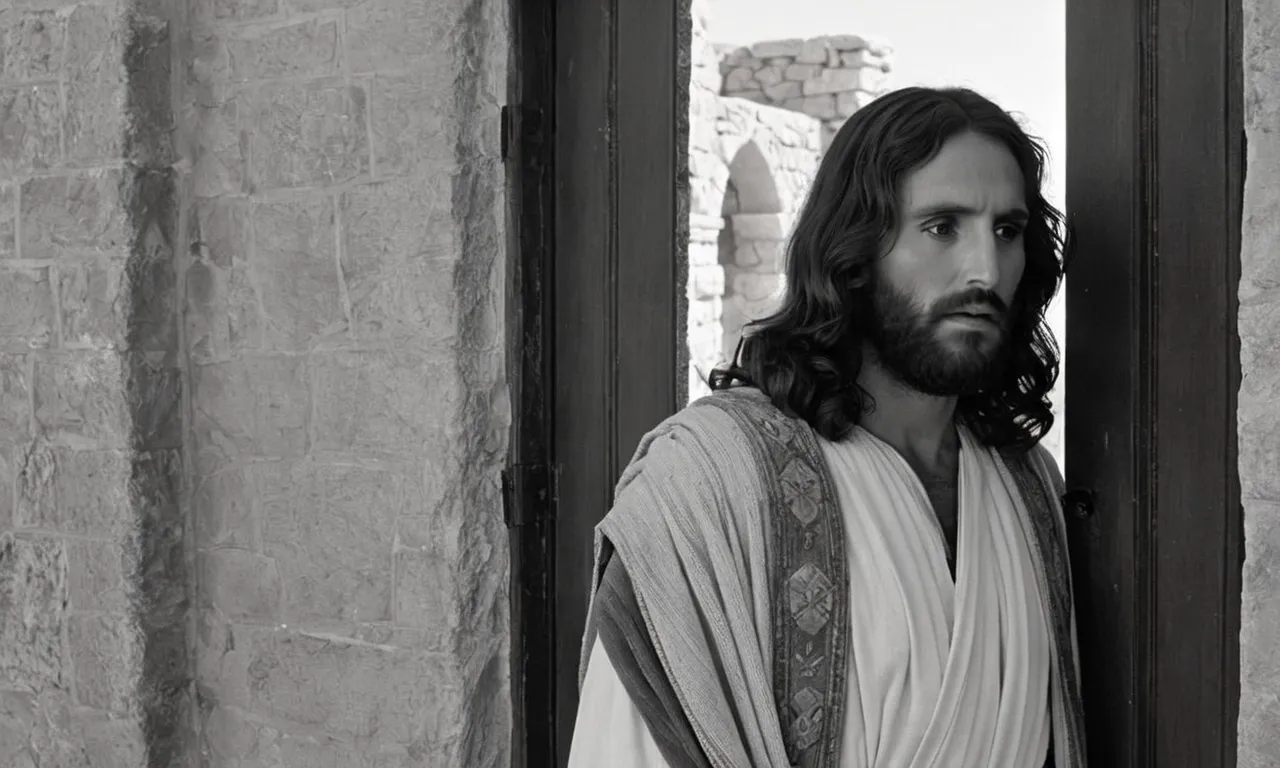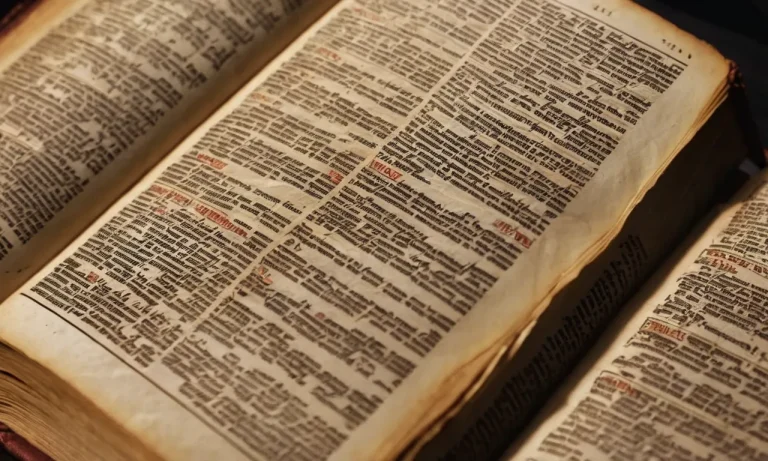Why Did Jesus Fold The Napkin After His Resurrection?
The folded napkin after Jesus’ resurrection has long intrigued Christians. This small detail conveys powerful symbolism about Christ’s victory over death. If you’re short on time, here’s a quick answer:
In this article, we will explore the meaning behind Jesus folding the linen burial cloth, drawing connections to ancient Jewish burial customs, and the symbolic act of a master finishing a meal.
We’ll examine Gospel accounts of the empty tomb and highlight what Jesus folding the napkin reveals about his mission, sacrifice, and victory over sin and death through the resurrection.
The Folded Napkin in Gospel Accounts of Jesus’ Tomb
Details from John’s Gospel
The Gospel of John provides intriguing details about the state of Jesus’ burial clothes after his resurrection.
John records that when Peter and John entered the empty tomb, they saw the linen burial cloths lying there, along with the face cloth that had been wrapped around Jesus’ head.
The face cloth was folded up and separate from the other linens (John 20:6-7). This has led many to wonder why John bothered to comment on such a small detail as a folded face cloth.
Some biblical scholars believe this detail highlights that Jesus’ resurrection was not in haste, but was an orderly and deliberate event.
If someone had stolen Jesus’ body, they likely would have grabbed everything including the face cloth and ran off quickly.
But here the cloths are left neatly behind with the face cloth carefully folded on its own.
The folded face cloth in John 20 has also brought to mind Jewish burial customs of that day. Specific practices were followed for preparing a body for burial. Knowing this cultural background gives further insight into the meaning of the folded napkin in Jesus’ tomb.
Connections to Jewish Burial Customs
In Jesus’ day, the Jewish custom was to wrap a person’s face with a cloth napkin known as a sudarium when they died. The Jews had specific burial procedures they carefully followed based on biblical law and tradition.
When Lazarus died as recorded in John 11, his face was wrapped with a cloth (John 11:44). This was a common Jewish burial practice.
After preparing the body, the Jews would wrap it tightly in long linen strips smeared with spices like myrrh and aloes.
This is what Joseph of Arimathea and Nicodemus did when they buried Jesus’ body after hastily removing it from the cross just before sunset (John 19:38-42).
The Jews did not embalm bodies, so wrapping them tightly with linen strips helped minimize odor and decay.
According to early church history, Peter and John would have understood what that folded face cloth in the empty tomb meant from their Jewish heritage. When a Jew died, it was customary to go back to his house to check for signs of life before final burial.
If the person revived and got up, they would loosen the face cloth letting it drop to the floor.
But if the person stayed in a permanent death, their family or friends returned to the body to wrap another cloth under the chin and tie it at the head to keep the lower jaw closed.
After securing this cloth, the sudarium was neatly folded and placed nearby.
So finding that face cloth neatly folded in the empty tomb would have immediately told Peter and John what had happened. Jesus had voluntarily risen from a permanent death!
This explains John’s preoccupation with recording the details of the linen wrappings and folded face cloth left behind (John 20:6-8).

Symbolic Meanings Behind Folding the Napkin
A Master Finishing a Meal
In Jesus’ day, when a servant finished serving a meal, he would fold his napkin in a certain way to let the master know he was finished.
The folded napkin meant “I’m done” or “I have finished my assignment.” But after Jesus’ resurrection, the Bible says his burial cloth (napkin) was folded and laying separate from the other burial cloths.
This act of folding the napkin was Jesus’ way of communicating to the disciples, and to us, that he was finished with his task of providing salvation for all who would accept it. His sacrificial assignment was completed!
Departing the Tomb With Purpose
The folded napkin also symbolized Jesus’ departure from the tomb with intention and purpose. He did not simply rise and leave in haste.
But with calm and gentleness, like a servant finishing his work, Jesus folded the napkin and laid it aside before exiting the tomb and appearing to his disciples.
This underscores that Jesus was in complete control throughout his crucifixion, death, burial, resurrection and beyond. His sacrifice was made willingly out of love for humanity.
This purposeful folding of the napkin also reminds us that Jesus has lovingly prepared a place for those who put their faith in him, just as he told his disciples in John 14:2-3. One day, believers will dwell with Christ forever.
When he returns, Jesus will gather his people to himself, mission accomplished.
His Sacrifice Complete, Victory Won
Jesus’ folding of the napkin proclaimed “it is finished!” (John 19:30). His work of atonement was now fully accomplished.
The ransom for sin was paid in full. Through his broken body and spilled blood on the cross, Christ had defeated sin and death once for all.
The victory cry was implied in the neatly folded burial cloth left behind. The risen Savior had conquered the grave, paving the way for eternal life for all who believe in him.
This simple act of folding the face cloth also sends the message that we serve a risen, orderly and tidy Savior.
Jesus is not sloppy, chaotic or haphazard. Even in leaving the tomb, He was neat and methodical, indicating his sovereignty and control even over the grave.
As the hymn says, “Up from the grave He arose, with a mighty triumph o’er His foes.” That victory is symbolized in the folded face cloth left behind by the risen Lord.
What Jesus’ Folded Napkin Reveals About His Resurrection
His Promise Fulfilled, Mission Accomplished
When Jesus rose from the dead, the Bible records that the cloth that had covered his face was folded neatly in the tomb (John 20:7).
This small detail carries great significance. The folded napkin symbolized that Jesus had finished the work he came to do and fulfilled his promise to rise again.
Just as Jesus told his disciples ahead of time, he suffered, died, was buried, and on the third day was resurrected, never to die again (Luke 9:22; Revelation 1:18). His purpose in coming was complete. As Jesus declared on the cross, “It is finished!” (John 19:30).
The mission he was sent to accomplish was now fully accomplished.
Sin and Death Defeated, Salvation Secured
The Bible declares, “The wages of sin is death” (Romans 6:23). Jesus came to defeat sin and death and open the way for people to find salvation and eternal life (John 10:10; 3:16).
By living a sinless life, dying on the cross for our sins, and conquering the grave, Jesus paid the penalty for our sins so we could be saved.
The neatly folded napkin announced that sin and death no longer had final power or say. With Jesus’ resurrection, God “gives us the victory through our Lord Jesus Christ” (1 Corinthians 15:57). Salvation was now available for all people through faith in Christ.
Proof of His Divinity and Power Over Grave
The methodical folding of Jesus’ face cloth also evidenced divine work. Asologias pointed out, the orderly, undisturbed folded napkin contrasted with the strips of linen and cloth found strewn around the tomb from Lazarus’s resurrection.
Jesus’ resurrection displayed purposed intent, proving his victory over death.
In addition, Jesus had prophesied he would rise after three days in the tomb (John 2:19; Matthew 12:39-40). The precisely wrapped face cloth offered one striking proof that Jesus is who he claimed – the resurrected Son of God.
Today, 2.38 billion people, nearly one-third of the planet’s population, identify as Christians, reaping the benefits from Jesus’ mission completed over 2000 years ago (Pew Research).
The folded napkin still testifies – his sacrifice finished, salvation secured, death defeated for eternity.
Conclusion
The folded face cloth in Jesus’ empty tomb carries great theological significance for Christians, revealing deep truths about Christ and His resurrection.
This small detail conveys that Jesus finished His work of atonement, departed the grave as the rightful Master and Conqueror of death, and proved His power over sin, hell and the grave through his bodily resurrection, securing salvation for all who put faith in Him.








